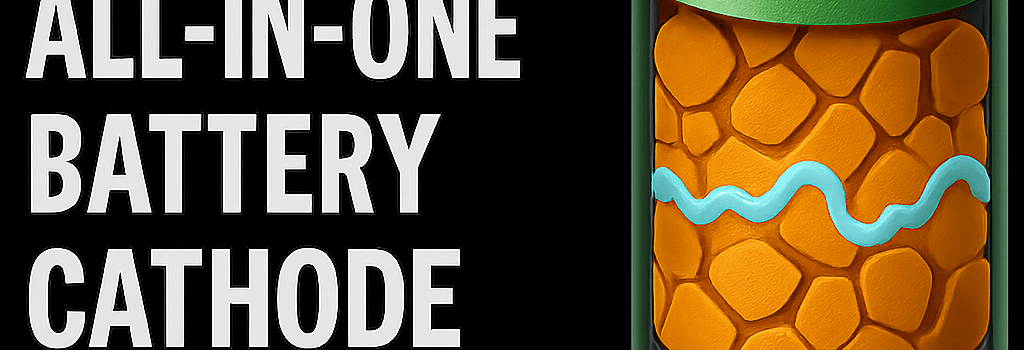Self-Healing All-in-One Battery Cathode Unveiled

Introduction
The quest for high-performance battery electrodes often leads to complex composites combining active materials, solid electrolytes, and conductive additives. Interfaces between these phases, however, can degrade over time, reducing capacity and cycle life. A team of researchers has now introduced a single-phase material—Li1.3Fe1.2Cl4—that simultaneously conducts electrons, shuttles Li+ ions, stores charge, and even self-heals mechanical damage during cycling.
Design and Synthesis of Li1.3Fe1.2Cl4
Crystal Structure and Diffusion Pathways
Density functional theory (DFT) simulations reveal that Li1.3Fe1.2Cl4 adopts a halide framework built from face-sharing FeCl6 octahedra arranged in d8 configurations. Each unit hosts variable Li sites on shared edges and interstitial voids. Nudged elastic band (NEB) calculations predict Li+ migration barriers of 0.25–0.35 eV, corresponding to an ionic conductivity on the order of 10−9 S/cm at room temperature. Bader charge analysis indicates a mixed Fe(II/III) redox process centered around 2.8–3.2 V vs. Li/Li+.
Synthesis Protocol
The material is synthesized via high-energy ball milling of LiCl, anhydrous FeCl2, and FeCl3 (molar ratio 1.3:0.65:0.55). The powders are milled at 500 rpm for 12 hours with a ball-to-powder ratio of 10:1, then annealed under argon at 200 °C for 16 hours. Yield exceeds 90%, with phase purity confirmed by X-ray diffraction. Ongoing scale-up efforts are exploring spray-drying and sol-gel routes to replace lab-scale milling.
Electrochemical Performance
- Specific capacity: 140 mAh/g at C/2 (1C ≈ full discharge in 1 hour)
- Rate capability: 120 mAh/g at 2C; capacity retention improves at higher rates due to enhanced ductility
- Cycle life: >90% capacity retention after 3,000 cycles at 4C charge/discharge (≈15 minute full charge)
- Operating voltage window: 2.4–3.6 V; average 3.1 V
- Volume change: ~8% expansion upon full lithiation
- Electronic conductivity: 1 × 10−4 S/cm, boosted to 1 × 10−2 S/cm with 2 wt% conductive carbon addition
Self-Healing Mechanism
In-situ transmission electron microscopy shows that as cells cycle, Li+ deintercalation induces a low-temperature phase transition that lowers the melting point locally to ~180 °C. Joule heating during fast charging brings grain boundaries into a ductile regime, enabling cracks and voids to flow and re-anneal. Post-mortem focused-ion-beam microscopy confirms that microcracks observed in pristine electrodes disappear after just one charge.
Deeper Analysis
Scaling and Manufacturing Challenges
While ball milling is standard in research, industrial cathode production favors continuous processes like co-precipitation and spray pyrolysis. The research team is collaborating with a battery startup to trial a spray-drying synthesis, aiming for sub-micron particle sizes and controlled morphology. Cost analysis suggests raw materials cost under $15 /kg, comparable to lithium iron phosphate (LFP), but process optimization remains key.
Integration in EV Battery Packs
Because Li1.3Fe1.2Cl4 doubles as a solid-state electrolyte, it can form ultra-thin interlayers (<10 µm) on high-capacity cathodes like NMC or LiCoO2. This dual function stabilizes high-voltage interfaces and suppresses transition-metal dissolution. Preliminary pouch cell tests (2 Ah, 50 % cathode loading) show 85 % capacity retention after 500 cycles at 1C.
Comparative Analysis with Conventional Cathodes
Compared with LFP, Li1.3Fe1.2Cl4 offers similar cycle life but at an average voltage ~0.4 V higher, boosting energy density by 15 %. Against NMC, it trades lower gravimetric capacity (140 mAh/g vs. 180 mAh/g) for improved thermal stability and safety, as the chloride matrix resists oxygen release at high states of charge.
Expert Opinions and Industry Outlook
“Halide frameworks like Li1.3Fe1.2Cl4 represent a new paradigm in cathode design—combining multifunctionality in a single phase,” said Dr. Maria Sanchez, senior scientist at Argonne National Laboratory. “The self-healing behavior is particularly exciting for fast-charging applications.”
Professor Wei Zhang (MIT) adds, “Scaling remains the largest hurdle. However, early talks with pilot-line manufacturers indicate that spray-drying can reproduce the critical microstructure with minor tweaks.”
Conclusion and Future Directions
Li1.3Fe1.2Cl4 demonstrates that halide-based, multifunctional cathode materials can overcome long-standing trade-offs between conductivity, capacity, and cycle life. With DOE funding secured for a 10 kg pilot run in 2026, the technology is moving rapidly toward industrial demonstration. Further work will target doping strategies to push operating voltages above 3.5 V and reduce volume changes below 5 %.